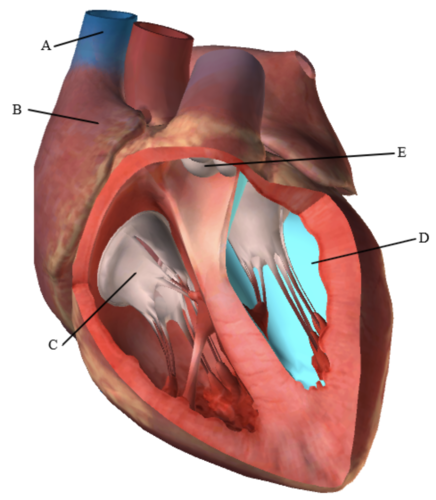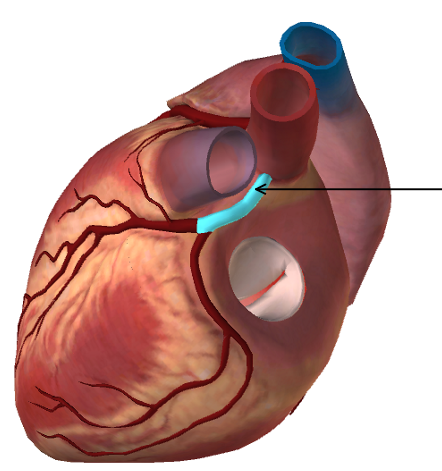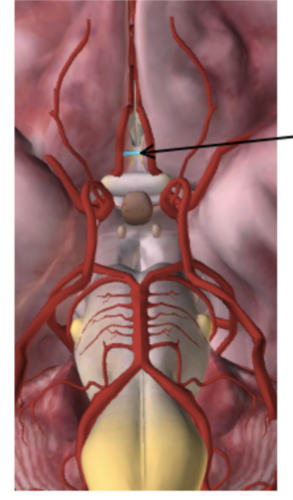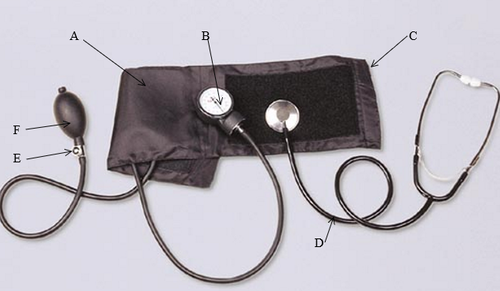Exam 4
1/45
There's no tags or description
Looks like no tags are added yet.
Name | Mastery | Learn | Test | Matching | Spaced |
|---|
No study sessions yet.
46 Terms
Which body system supplies cells with oxygen and nutrients and carries away waste?
Circulatory System
The heart is contained in the _______ cavity.
Pericardial
Which layer of heart anchors it to the diaphragm?
Pericardium
What is the purpose of the mitral valve?
The mitral valve controls the flow of blood from the left atrium into the left ventricle.
Which layer of heart is composed of the contractile cardiac muscle?
Myocardium
What is the purpose of the fossa ovalis in a fetus?
The fossa ovalis marks the place of an opening between the atria which is present in all developing fetuses. It allows fetal blood to move directly from right to le atrium, bypassing he undeveloped lungs. The fossa ovalis closes during birth so that the lungs can receive oxygen once the baby is born.

Label the figure below (A-E):
A:
B:
C:
D: (In blue)
E:
A: Superior Vena Cava B: Right Atrium C: Tricuspid/Right AV valve D: Left ventricle E. Pulmonary Valve

Name the vessel in the figure below: (highlighted in blue, also indicated by the arrow
Right Coronary Artery

Name the vessel in the figure below: (highlighted in blue, also indicated by the arrow)
Circumflex branch

Name the vessel in the figure below: (highlighted in blue, also indicated by the arrow)
Left Coronary Artery
True or False: Veins carry blood towards the heart.
True
True or False: Arteries have high amounts of stretch with little recoil.
False
Which vessel would you expect to be the best place to feel a strong pulse?
Common carotid/ subclavian artery
What is the correct order of blood flow starting from the heart?
Artery → arteriole → capillary → venule → vein
Tunica media
Which layer of a vessel contains the muscular layer?
Which layer of a vessel helps anchor it to the surrounding structures?
Tunica externa
The aortic arch turns to become the _______?
Descending aorta
A patient had a stroke in their frontal lobe. What vessel was most likely blocked?
Anterior cerebral artery
These two arteries of the circle of Willis rise along both sides of the spinal cord, joining in the brainstem:
Vertebral arteries (left and right)
These two arteries of the circle of Willis arise from the common carotid arteries in the neck.
Internal carotid arteries (left and right)

What is the name of the artery in the figure below (in blue also indicated by the arrow)?
anterior communicating artery

Use the figure below to answer the following question.
Which part of the medical equipment (B-F) is squeezed to inflate A?
F. The bulb

Use the figure below to answer the following ques on. Por on A is filled with air. Which part of the medical equipment shown below (B-F) releases the air from A?
E. The valve
True or False: The cell portion of blood is called formed elements.
True
True or False: The liquid portion of blood is called formed elements.
False
True or False: Hydrostatic pressure is the net pressure which pushes fluid into the tissues.
True
The average pH of blood is near:
7.4
The portion of blood responsible for maintaining blood pH is:
Plasma
A_______ does not contain a nucleus:
red blood cell
Which statement is true concerning the events in the coagulation cascade?
Prothrombin is converted to thrombin.
Oxygenated blood is pumped from heart through the _______to the rest of the body.
Left, systemic circuit
The ______ sends deoxygenated blood to the lungs to be oxygenated
Right, pulmonary circuit
The "pacemaker of the heart" is in what location?
Right atrium
You are reviewing your patient’s results from an EKG. The findings indicate a problem with ventricular depolarization. Where should you look on the EKG to find this abnormal rhythm?
QRS complex
Which statement is true concerning the events in the coagulation cascade?
Prothrombin is converted to thrombin.
You are reviewing your patient's results from an EKG. The findings indicate a problem with ventricular repolarization. Where should you look on the EKG to find this abnormal rhythm?
T-wave
Your patient's EKG results indicate difficulty with left and right atrial systole. What part of the conduction system is not functioning properly?
SA node
Which statement is true concerning the cardiac cycle
The ventricular contraction time is longer than the atrial contraction time.
A patient is suspected to have pulmonary edema due to congestive heart failure. Which side of the heart would be in failure? Explain your answer
The left side of the heart would be in failure. If the left side of the heart cannot pump blood out to the body tissues efficiently, blood and fluid will back up into the lungs
A patient is suspected to have peripheral edema due to heart failure. Which side of the heart would be in failure? Explain your answer.
A patient has a diagnosis of left sided heart failure. Which of the following signs/symptoms would they most likely present with?
Shortness of breath at rest
A patient is admitted to the ER with a thromboembolism. Your patient is given t-PA. Why?
To help dissolve blood clots
A patient is admitted to the ER with a myocardial infarction. What signs/symptoms could they display?
A. Shortness of breath
B. Angina pectoris
C. Heartburn
D. Pressure over the chest
A patient is suspected to have peripheral edema due to heart failure. Which side of the heart would be in failure? Explain your answer.
The right side of the heart would be in failure. If the right side of the heart cannot pump blood into the heart efficiently, blood and fluid will back up into the veins, causing swelling in body tissues.
Your patient has a diagnosis of atherosclerosis. Is your patient at a higher or lower risk for a thromboembolism? Explain your reasoning.
Higher risk. Thromboembolism is an embolus that becomes lodged in a vessel as it travels. Atherosclerosis is an accumulation of soft masses of fatty materials, often cholesterol, inside arteries. These deposits called plaque accumulate beneath the inner linings of arteries. Plaque can cause a clot to form on the irregular arterial wall. If the clot becomes dislodged it can travel and clog a smaller artery in its path.
Your patient is admitted to the hospital for a coronary artery bypass. Use your own words to explain to your patient about what is going to happen in this surgery.
During this operation, a segment of another blood vessel from the patient’s body and stitch one end of the aorta and the other end to a coronary artery past the point of obstruction. Once the heart is exposed, some physicians may also use lasers to open clogged coronary vessels.